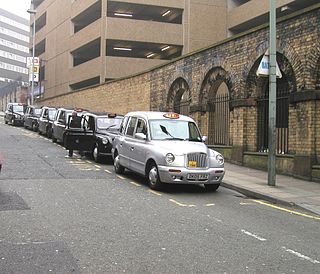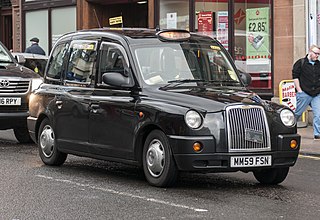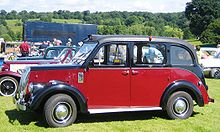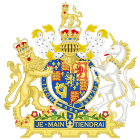
The hansom cab is a kind of horse-drawn carriage designed and patented in 1834 by Joseph Hansom, an architect from York. The vehicle was developed and tested by Hansom in Hinckley, Leicestershire, England. Originally called the Hansom safety cab, it was designed to combine speed with safety, with a low centre of gravity for safe cornering. Hansom's original design was modified by John Chapman and several others to improve its practicability, but retained Hansom's name.

A vehicle for hire is a vehicle providing private transport or shared transport for a fee, in which passengers are generally free to choose their points or approximate points of origin and destination, unlike public transport, and which they do not drive themselves, as in car rental and carsharing. They may be offered via a ridesharing company.

A suicide door is an automobile door hinged at its rear rather than the front. Such doors were originally used on horse-drawn carriages, but are rarely found on modern vehicles, primarily because they are less safe than a front-hinged door. Being rear-hinged, if the vehicle was moving and the door opened, aerodynamic drag would force the door open, and the driver/passenger would have to lean forward and out of the vehicle to close it. As seat belts were not in common use at that time, the risk of falling out of the car and into traffic was high, hence the name "suicide door".. Another reason could have been that while a door was open on a city street, a speeding car moving in the same direction as the parked car could rip a front-hinged door off the parked car but someone in side the adjacent seat, even if moving to leave the car, could not get scratched. However, with a suicide door, someone inside or partially outside the passenger compartment would get struck by the suicide door forcefully swinging back to a shut position due to the impact of the speeding car.

The Austin FX4 is a hackney carriage that was produced from 1958 until 1997. It was sold by Austin from 1958 until 1982, when Carbodies, who had been producing the FX4 for Austin, took over the intellectual rights to the car. Carbodies only produced the FX4 for two years, until 1984, when London Taxis International took over rights and continued producing it until 1997. In all, more than 75,000 FX4s were built.

A horse-drawn vehicle is a piece of equipment pulled by one or more horses. These vehicles typically have two or four wheels and were used to carry passengers or a load. They were once common worldwide, but they have mostly been replaced by automobiles and other forms of self-propelled transport but are still in use today.
Carbodies was a taxi design and manufacturing company based in Coventry, England. In its latter years it also traded as London Taxis International and The London Taxi Company.

The LTI TX1 is a Hackney carriage introduced by London Taxis International in 1997 and designed to replace the ageing Austin FX4. It was designed by British product designer Kenneth Grange.
Taxicabs within a country often share common properties, but there is a wide variation from country to country in the vehicles used, the circumstances under which they may be hired and the regulatory regime to which these are subject.
The taxicabs of the United States make up a mature system; most U.S. cities have a licensing scheme which restricts the number of taxicabs allowed. As of 2012 the total number of taxi cab drivers in the United States is 233,900; the average annual salary of a taxi cab driver is $22,820 and the expected percent job increase over the next 10 years is 16%.

Taxicabs are regulated throughout the United Kingdom, but the regulation of taxicabs in London is especially rigorous with regard to mechanical integrity and driver knowledge. An official report observed that: "Little however is known about the regulation by anyone outside the trade. The Public Carriage Office (PCO), which regulates and licenses taxis and private hire was transferred from the Metropolitan Police to become part of Transport for London in 2000." In 2015, there were around 298,000 licensed drivers in England, of which 164,000 were private hire licences, 62,000 were taxi licences and 72,000 were dual licences.

The TX4 is a purpose-built taxicab manufactured by The London Taxi Company, a subsidiary of Geely Automobile of China. From 2007 until their liquidation in 2013 it was manufactured by LTI. It is the latest in a long line of purpose-built taxis produced by The London Taxi Company and various predecessor entities. The design has evolved via several mutations from the Austin FX3 of the 1950s. TX4's immediate predecessor is the TXII.

The Metropolitan Conditions of Fitness for Taxis set out the requirements for vehicles that may be used as licensed Hackney carriage taxi cabs in London. They are what makes London's taxis unique in the world and are governed by Transport for London's Taxi and Private Hire office.

Taxis in Australia are highly regulated by each Australian state and territory, with each state and territory having its own history and structure. In December 2014, there were 21,344 taxis in Australia. Taxis in Australia are required to be licensed and are typically required to operate and charge on a fitted taximeter. Taxi fare rates are set by State or Territory governments. A vehicle without a meter is generally not considered to be a taxi, and may be described, for example, as a hire car, limousine, carpool, etc. Most taxis today are fueled by liquid petroleum gas. A2B Australia owns and operates the Cabcharge payment system, which covers 98% of taxis in Australia, and operates one of Australia's largest taxi networks.

The Austin FX3 is a taxicab that was sold in the United Kingdom by Austin from 1948 to 1958. It was designed to comply with the Metropolitan Police Conditions of Fitness for London taxicabs, but was also used in other towns and cities in the UK. It was commissioned from Austin by taxi dealers Mann & Overton and built by Carbodies of Coventry on a chassis supplied by Austin.
Illegal taxicabs, sometimes known as pirate taxis, gypsy cabs, or jitney cabs, are taxicabs and other for-hire vehicles that are not duly licensed or permitted by the jurisdiction in which they operate. Most major cities worldwide require taxicabs to be licensed, safety-inspected, insured as for-hire vehicles, and to use taximeters, and there may also be requirements that the taxi driver be registered or accredited. However, many unlicensed cabs are in operation. Illegal cabs may be marked taxi vehicles, and others are personal vehicles used by an individual to offer unauthorized taxi-like services. Illegal cabs are prevalent in cities with medallion systems, which restrict the number of legal cabs in operation. Since their introduction in 2009, vehicles affiliated with ridesharing companies have been classified as illegal taxicabs in some jurisdictions.

A cabriolet is a light horse-drawn vehicle, with two wheels and a single horse. The carriage has a folding hood that can cover its two occupants, one of whom is the driver. It has a large rigid apron, upward-curving shafts, and usually a rear platform between the C springs for a groom. The design was developed in France in the eighteenth century and quickly replaced the heavier hackney carriage as the vehicle for hire of choice in Paris and London.

A taxi, also known as a taxicab or simply a cab, is a type of vehicle for hire with a driver, used by a single passenger or small group of passengers, often for a non-shared ride. A taxicab conveys passengers between locations of their choice. This differs from public transport where the pick-up and drop-off locations are decided by the service provider, not by the customers, although demand responsive transport and share taxis provide a hybrid bus/taxi mode.

The LEVC TX is a purpose-built hackney carriage manufactured by the British commercial vehicle maker London EV Company (LEVC), a subsidiary of the Chinese carmaker Geely. It is the latest in a succession of purpose-built hackney carriages produced by LEVC and various predecessor entities. The LEVC TX is a plug-in hybrid range-extender electric vehicle.

London Electric Vehicle Company (LEVC), formerly The London Taxi Corporation Limited, is a British automotive manufacturer with its headquarters at Ansty Park near Coventry, England. It is a wholly-owned subsidiary of Chinese automaker Geely. The company produces London’s famous black taxicabs. Much of the engineering is done by China Euro Vehicle Technology, a Geely subsidiary based in Gothenburg, Sweden.

The Ecotive Metrocab, first presented in December 2013, is a purpose-built electrically powered hackney carriage manufactured by Ecotive, a subsidiary of Kamkorp. The vehicle is designed to comply with Transport for London’s taxi regulations, which, from 1 January 2018, ban new diesel-powered taxis and require zero-emissions capability.







































